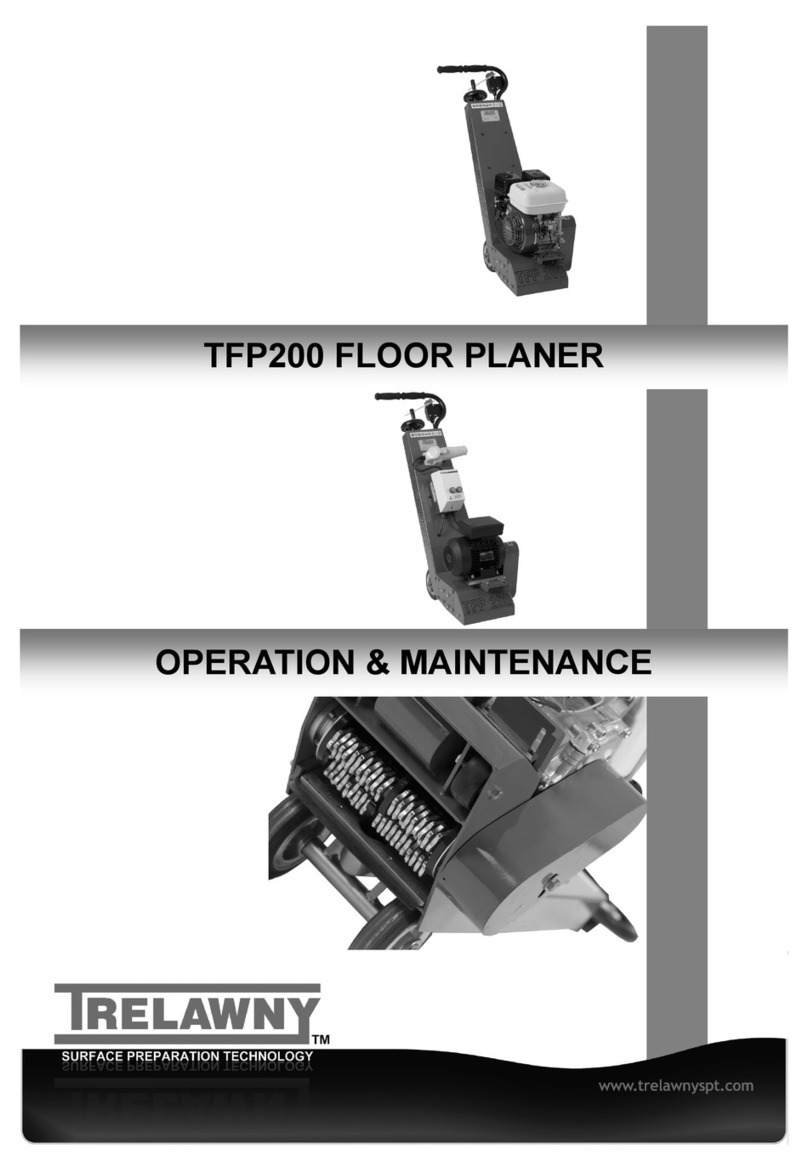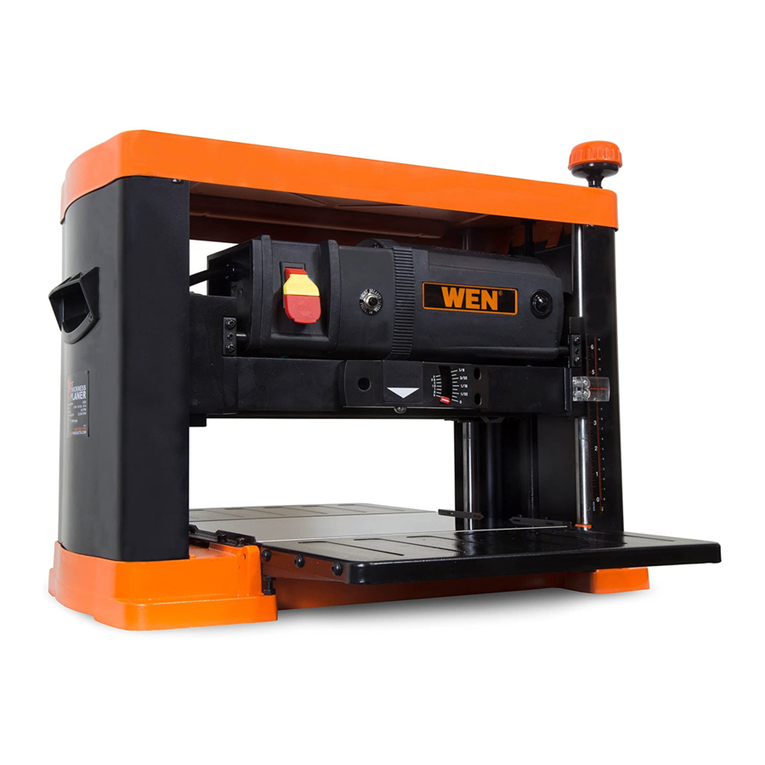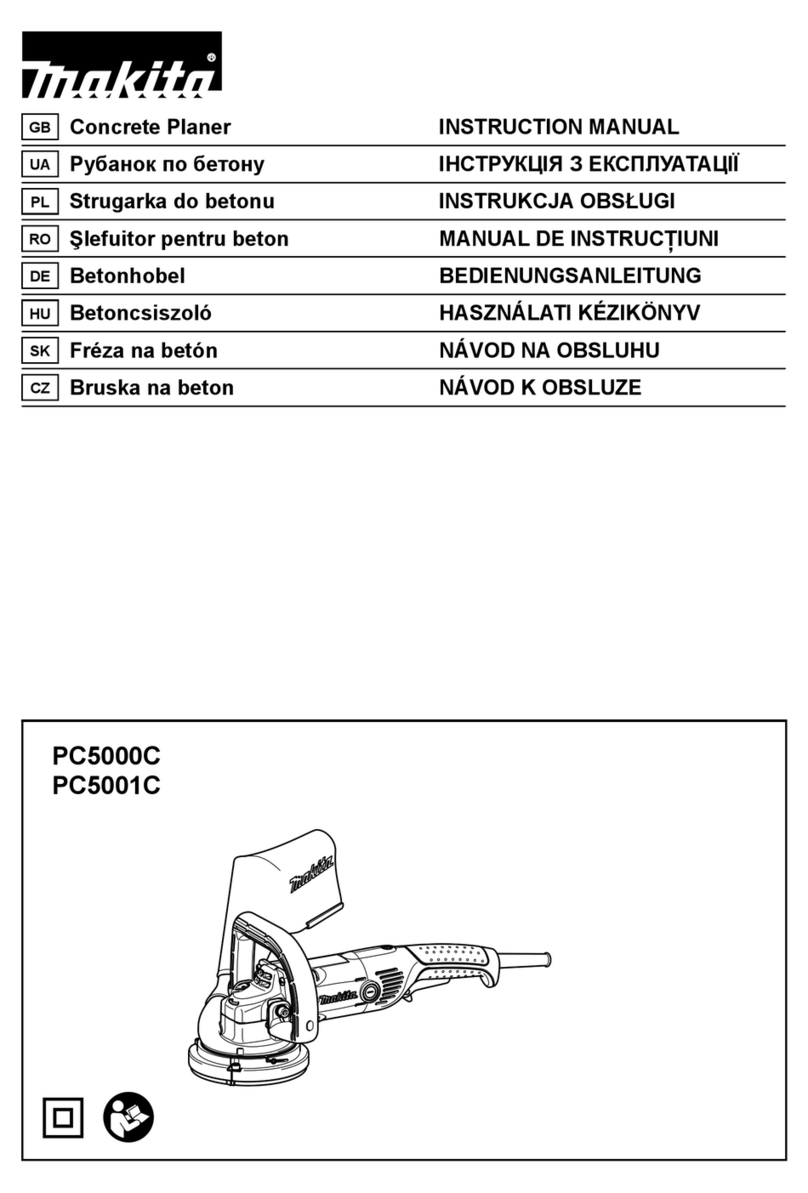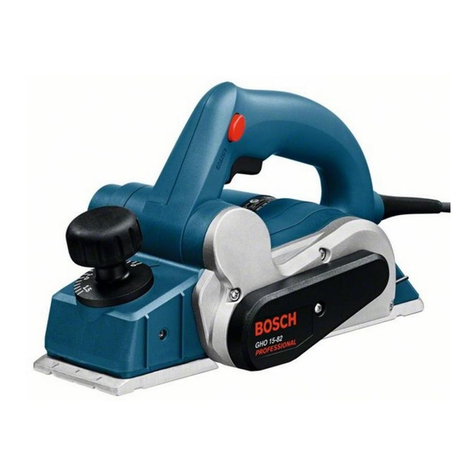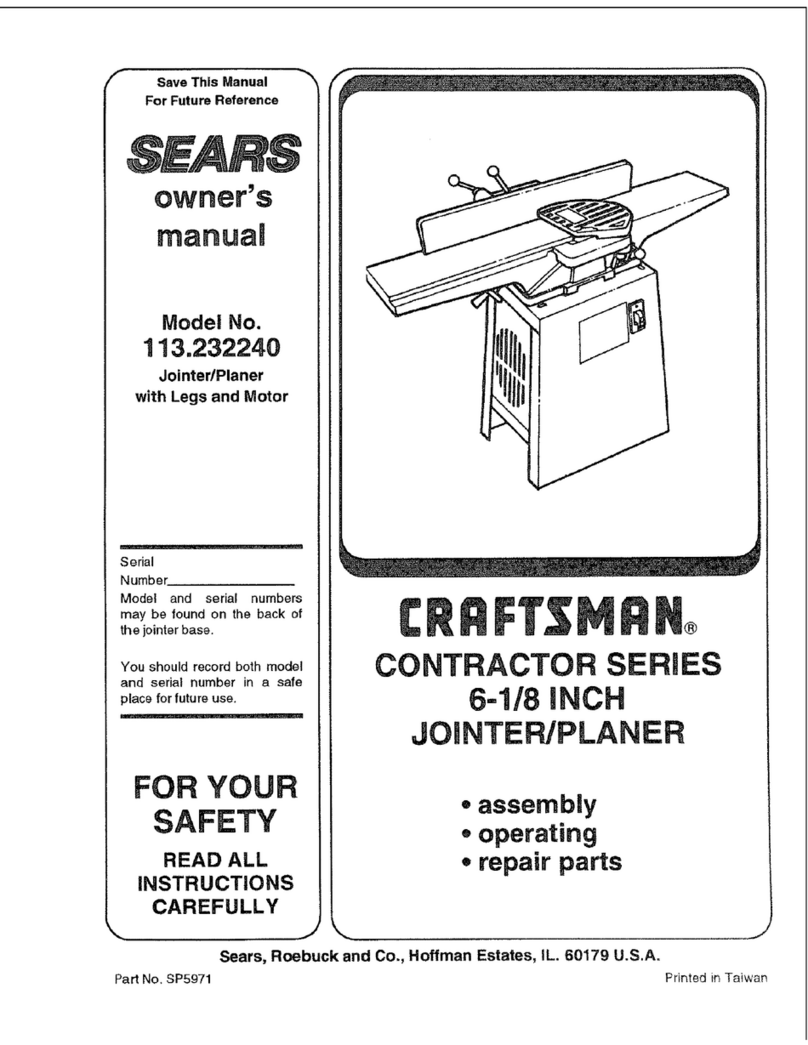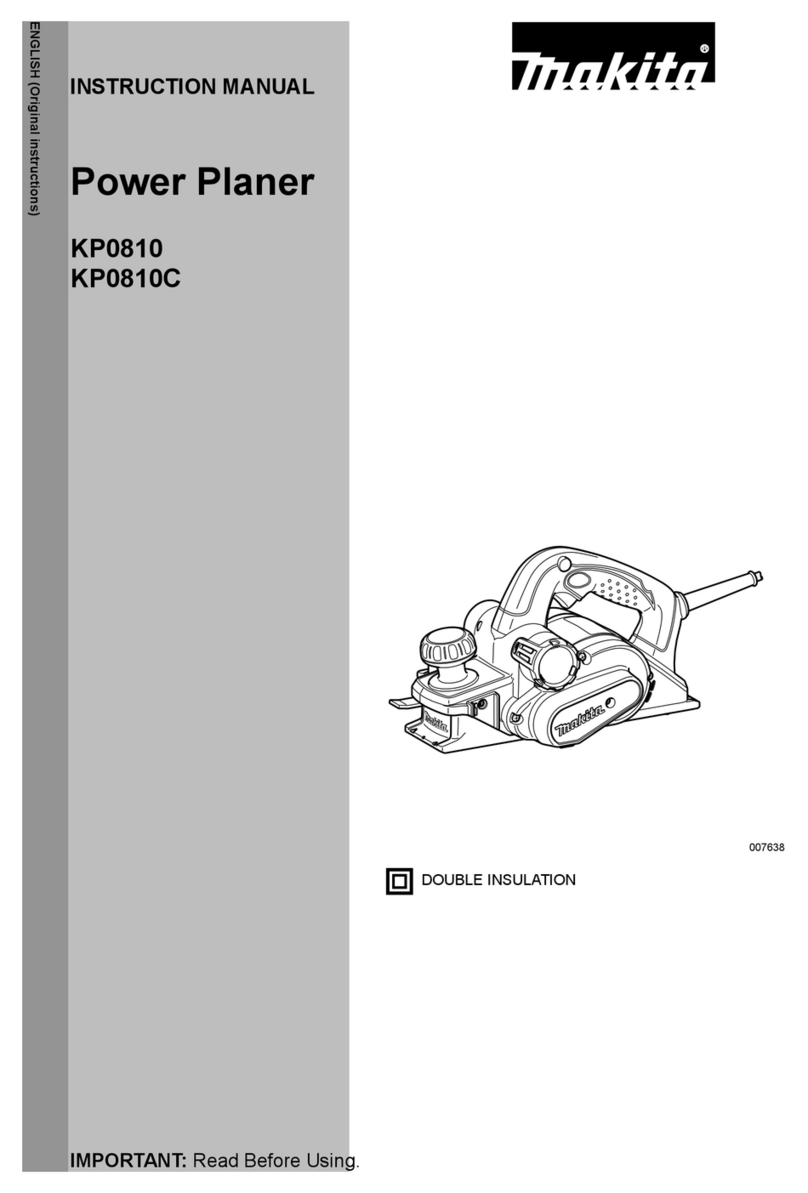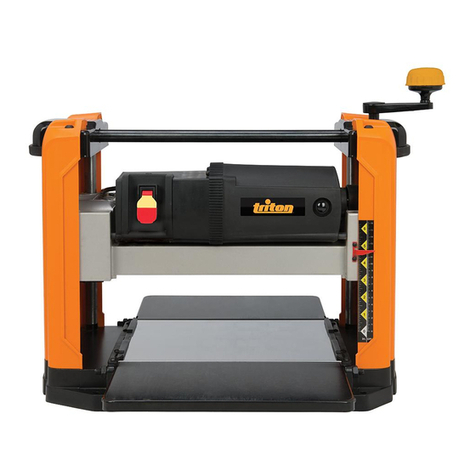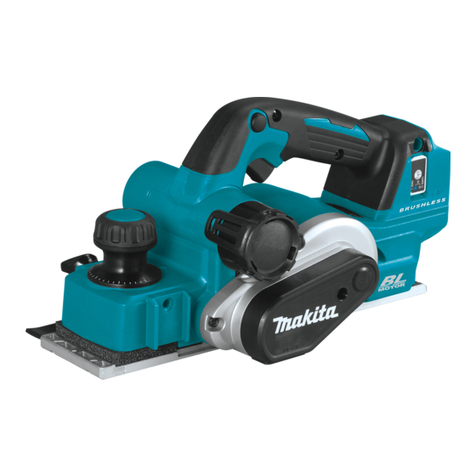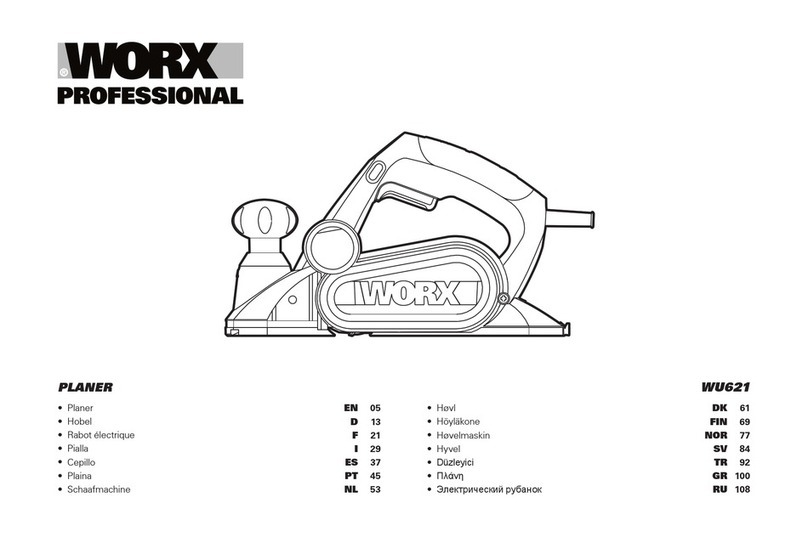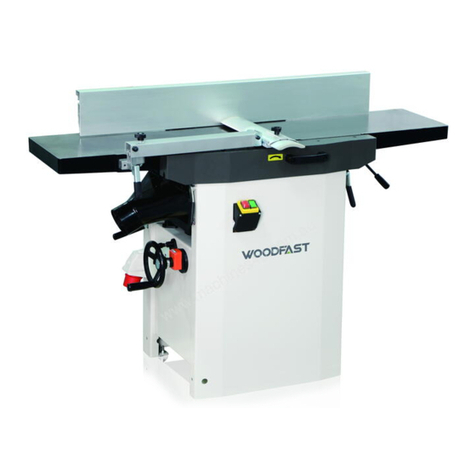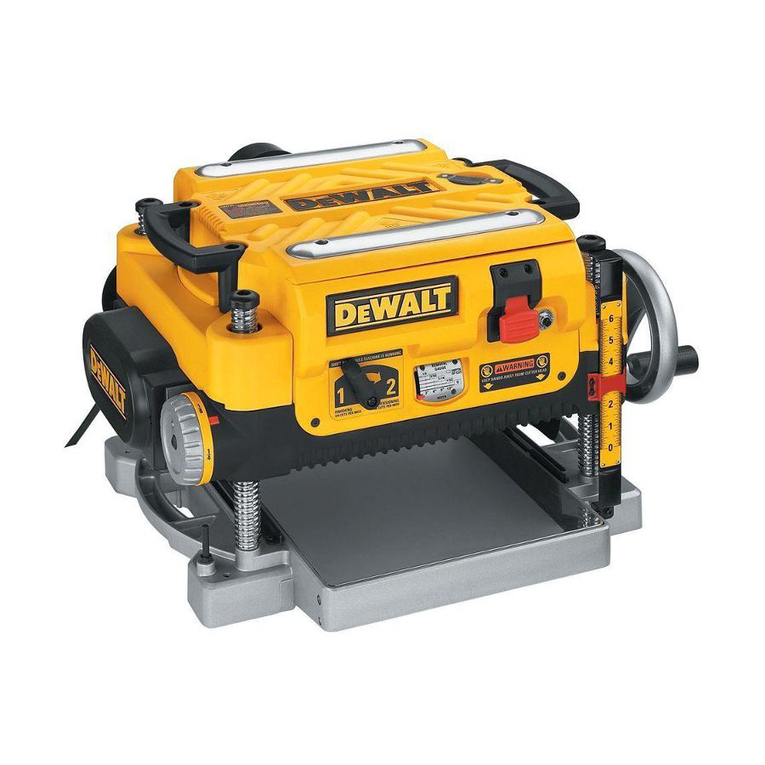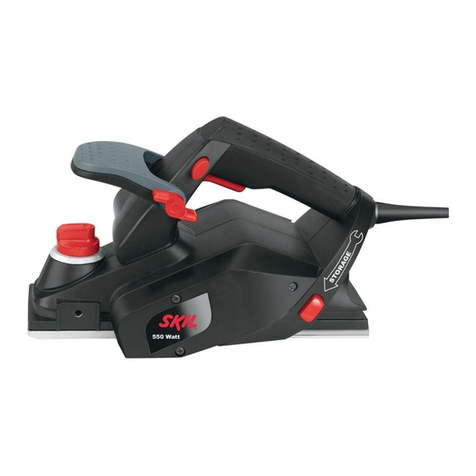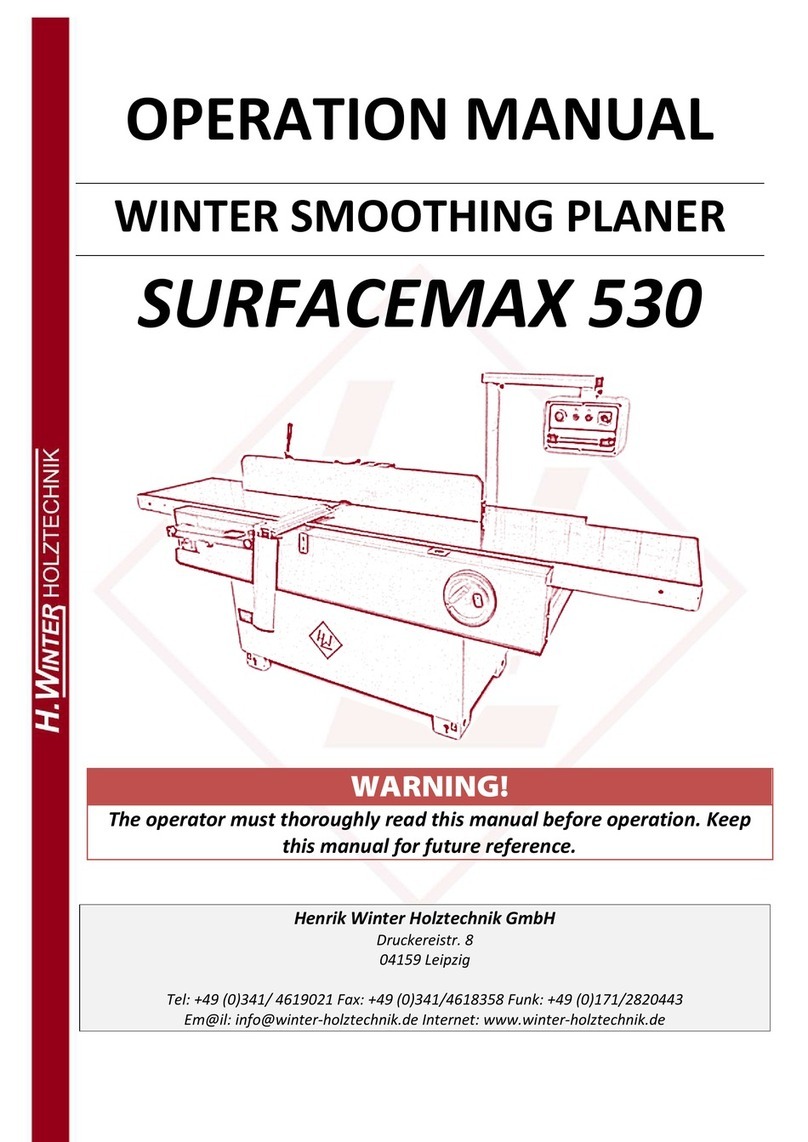Trelawny TFP260 Troubleshooting guide

TFP260 FLOOR PLANER
OPERATION & MAINTENANCE

OPERATION
Foreword
Thank you for your purchase of the
TRELAWNY TFP260 Floor Planer.
This manual contains the necessary
maintenance information for you to ensure
proper operation and care for this machine.
See also the manual that is supplied by the
engine manufacturer.
It is essential for you to read through these
manuals thoroughly.
In the unlikely event that you experience
problems with your TFP260, please do not
hesitate to contact your local Trelawny dealer
or agent. We always welcome feedback and
comments from our valued customers.
General Information
Before operating, performing maintenance or
repairing the TFP260 FLOOR PLANER this
manual must be read and understood by the
operator, if in any doubt, ask your supervisor
before using this equipment.
Local safety regulations must be followed at
all times. Failure to follow these instructions
could result in damage to the TFP260 and/or
personal injury.
Trelawny SPT Limited disclaims all
responsibility for damage to persons or
objects arising as a consequence of incorrect
handling of the machine, failure to inspect the
machine for damage or other faults that may
influence the operation prior to starting work,
or failure to follow the safety regulations listed
or applicable to the job site.
This machine is primarily designed for the
removal of paint, heavy rust, scale and for the
removal of laitance from concrete from floor
areas. It can be used both indoors and out.
Electric models are more suitable for indoor
use because of the toxic gases that are
produced by petrol engines.
This machine must not be used in a fixture.
Safety
WEAR SAFETY BOOTS, FACE MASK,
SHATTERPROOF GLASSES, HELMET,
GLOVES and any other personal protective
equipment required for the working conditions.
Avoid loose clothing; this may become
trapped in moving parts and cause serious
injury.
TO AVOID NUISANCE DUST, connect an
industrial vacuum cleaner (minimum
3000watts or equivalent) to the 50mm (2”)
vacuum port situated at the rear of the
machine.
ENSURE THAT THE WORK PLACE IS WELL
VENTILATED. Avoid operating engine-
powered machines in an enclosed area, since
engine exhaust gases are poisonous.
BE VERY CAREFUL WITH HOT
COMPONENTS. Exhausts and other parts of
the engine are hot during operation and can
remain hot for some time after shutdown.
DO NOT REFUEL THE ENGINE WHILE THE
ENGINE IS HOT OR RUNNING, there is a
very real danger from explosion –always
refuel when the engine is cold, and in the
open air.
During transportation fasten fuel cap tightly
and close fuel cock.
DO NOT OPERATE ELECTRIC VERSIONS
IN WET CONDITIONS.
CAUTION THIS MACHINE IS HEAVY. It
weighs around (Wt 122 kg (269 lbs))
dependent on power unit. Do not lift this
machine manually.
IMPORTANT:
When fitted with the petrol engine, AVOID
TIPPING THE TFP260 BACKWARDS,
especially when hot; the engine oil can run
past the piston and into the combustion
chamber causing the piston to “hydraulic lock”
when next attempting to start the engine.
Never attempt to forcibly turn the engine over
if this has taken place, severe damage to the
engine can be caused, resulting in a costly
major strip down and possible injury to the
operator.
To remove the oil from the cylinder, first
remove the spark plug and place a lint free
cloth over the plughole to capture the
jettisoned oil. Turn the engine over with the
ignition switch and fuel cock in the off position
and expel as much of the oil as possible.
Clean the spark plug to remove oil from the
electrodes and replace. The plug may have to
be removed and cleaned several times before
the engine will start. Upon starting, the engine
may produce smoke for a while from the
exhaust, but this should soon clear.
Finally stop the engine and recheck the
engine oil level. (Ensure that the engine is
level prior to carrying out this check). If the
engine oil level is low, refill with the
recommended motor oil - see engine
manufacturers operating instructions.
Risk of Hand-arm
Vibration injury
These tools may cause Hand-arm Vibration
Syndrome injury if their use is not adequately
managed.
We advise you to carry out a risk assessment
and to implement measures such as; limiting
exposure time [i.e. actual trigger time, not total
time at work], job rotation, ensuring the tools
are used correctly, ensuring the tools are
m a i n t a i n e d a c c o r d i n g t o o u r
recommendations, and ensuring that the
operators wear personal protective equipment
[PPE] particularly gloves and clothing to keep
them warm and dry.
Employers should consider setting up a
programme of health surveillance to establish
a benchmark for each operator and to detect
early symptoms of vibration injury.
We are not aware of any PPE that provides
protection against vibration injury by
attenuating vibration emissions.
See ‘Specifications’ section for vibration
emission data.
Further advice is available from our Technical
Department.
We strongly advise you to visit the Health &
S a fe t y E x e c ut i v e w e bs i t e h t t p: //
www.hse.gov.uk/vibration This site provides
excellent advice and information on HAV and
currently, includes a Hand-arm Vibration
Exposure Calculator that is easy to use to
work out the daily vibration exposure for each
of your operators.
Cutter types &
Applications
T.C.T
Hardened steel cutter with tungsten carbide
inserts. For all general cleaning applications,
including concrete texturing, Scabbling, the
grooving of concrete, removal of embedded
roof chippings, brittle coatings from steel
work. Use TCT Cutters on heavy applications,
for longer life and higher output. Produces
“tramlines” on concrete and small indentations
on steelwork.
STAR
Heat-treated steel cutters used for the
aggressive removal of Paint and coatings
from floor areas, but with a shorter life span
than Beam Cutters. Can be used for the
general removal of dirt and ice deposits and to
produce a texture on concrete surfaces.
Produces roughened surface on concrete and
some marking on steelwork.
BEAM
Heat-treated steel cutters used for the
removal of Paint and coatings from floor
areas, but with a shorter life span that TCT
Cutters, not as aggressive as Star Cutters.
Can be used for the general removal of dirt
and ice deposits. Produces a fine texture on
concrete surfaces and slight marking on
steelwork.
MILLING
Flat tungsten carbide cutters for the removal
of thermo-plastic road and runway markings.
Very efficient and cost effective with none of
the problems associated with burning off.
These can also be used for the removal of
bituminous and rubber deposits. Very
effective for the removal of two part epoxy
floor paint, may require finishing with beam
cutters or the Trelawny floor grinder to
achieve the required finish.
Note: Care must be taken with milling cutters
to ensure that the Drum and its Cutters are is
fitted the correct way round, the tungsten
carbide tips must face towards the vacuum
port at the bottom as the drum rotates,
otherwise the tips will be damaged in use.
Produces a “strip” on concrete and tarmac, is
not recommended on steelwork unless used
for “braking up” coatings.
NB: Increasing or decreasing the number of
spacers used can alter the performance and
finish characteristics of each cutter type.
Ensure that the same type and quantity of
spacers and cutters are fitted to the opposite
cutter shaft to maintain the drums balance. An
out of balance drum can be very dangerous
and will also dramatically increase the
vibration emissions.

OPERATION
Open the engine fuel cock.
Set the throttle lever on the engine to
approximately a halfway open position.
For cold engine starting, move the carburettor
choke lever to the choke "full on" position.
Set the engine switch to the "on" position.
Where fitted, pull the Hold to run lever
towards the handle bar.
Pull the recoil starter cord handle.
After the engine starts, open the choke
approximately halfway, or until the engine
runs smoothly. Warm the engine up for 2~3
minutes at half engine speed before opening
the choke fully.
The warm up procedure is particularly
important during cold weather.
Electric models: Follow instructions in
Starting at paragraph three, then pull the Hold
to run lever towards the handle bar, press
start button on control box. Continue
instructions with item 2,3 and 4 in Machine
Operation below.
Machine Operation
Ensure that the depth of cut adjustment hand
wheel is in the fully raised position and the cut
engagement lever is up.
On Petrol engines set the throttle lever on the
engine to fully "open/run" position.
Continue holding the handle bar and dead
mans handle in the "on" position.
Place the cut engagement lever in the forward
engaged position and slowly rotating
clockwise the depth of cut hand wheel (55).
The cut engagement lever (58) will move
forward/down while adjustment is made, if it
does not, ensure that the cut engagement
lever has been pushed to the forward position.
Adjust the depth of cut hand wheel until the
cutters are in contact with the surface, slowly
adding more cut until sufficient material is
being removed. Be aware that several lighter
cuts is more efficient than one heavy cut.
Heavy cuts will only increase wear of drum
components and increase operator fatigue.
The Planer may move forward during the
cutting operation, due to the action of the
cutter drum. Control this by holding the handle
bar. When planing rough surfaces the
machine may jerk forwards if too heavy a cut
is made. Reduce the amount of cut by raising
the cutters via the cutting depth adjustment
hand wheel (55).
Pre-Start Check
Check all bolts and screws for tightness.
Ensure that all fittings are secure.
Check the drive belt for correct tightness.
There should normally be approximately
13mm (1/2") of free play when one side of the
belt is depressed in the middle position
between the two pulleys. To set the belt
tension, refer to the Belt installation & Setting
section.
For Petrol Engines
Check engine oil level. If the engine oil level is
low, refill with the relevant motor oil
recommended in the engine manufacturers
operating and maintenance manual.
IMPORTANT: Do not lean the machine
backwards onto its handle to inspect the
cutters or drum. It is possible for engine oil to
seep into the cylinder bore, especially if the
engine is hot. If this has occurred,
DO NOT ATTEMPT TO START THE
ENGINE,
the oil can cause the piston to lock
hydraulically, which may cause severe
damage to the engine and injure the operator.
With ignition turned off, very slowly pull the
starter cord, if the engine cannot be turned
over, the above may have taken place.
Rectification will necessitate the spark plug
being removed and the engine turned over by
pulling the starter cord (with ignition turned
off) to “eject” the oil. Use a lint free clean cloth
over the plughole to capture the ejected oil.
The spark plug will require removing and
cleaning, possibly several times until the
engine restarts.
415v Motors
The TFP260 is supplied with a specially
commissioned electric motor and starter
switch assembly. Each unit is fully tested and
the overload relays have been calibrated and
set according to the manufactures
specifications. In the event of malfunction on a
new machine, the owner should first check
that the power supply on site is suitable and
adequate. All cables should be fully uncoiled
and never left wrapped around cable reels or
tied in loops. The starter box is fitted with a
safety feature to protect the motor and relays
from damage.
The starter boxes are preset and under no
circumstances should they be tampered with,
stripped down or adjusted, otherwise it will
invalidate the warranty.
Take particular care when using 415v
Machines; ensure that the electrical supply is
earthed and that breakers and fuses are
correct for the loading. The switches are
preset and under no circumstances should
they be tampered with, stripped down or
adjusted, otherwise it will invalidate the
warranty.
The 415v motor requires the minimum of a
10amp, 380v power supply
Always use the shortest possible length of
extension cable. To avoid voltage drop the
cable must have a minimum core wire size of
2.5mm2cross-section area.
Maximum length of cable 30 meters.
IMPORTANT
Do not pull the recoil starter cord to the end
of is travel as it may cause damage to the
engine or injury to the operator.
When the engine starts, recoil the cord
slowly.
Do not allow the cord to snap back to its
start position.
ENGINE VERSIONS
CAUTION
Beware of POISONOUS FUMES. Start and
operate only in well-ventilated areas.
Be careful with HOT COMPONENTS.
Exhausts and other engine parts are hot
during and for some time after operation.
Do not touch them.
Shut Down
All Versions
Raise the cutters using the drum cutting depth
adjustment hand wheel (55).
Lift the cutter engagement / disengagement
(58) lever to the raised position.
Electric version only, now release the hold
to run lever, the electric motor will then stop.
Petrol Engine Versions
Move the engine’s throttle lever to the slow
speed position and run the engine for 20
seconds, (This avoids the engine bore from
becoming washed internally by neat fuel.)
Where fitted, release the hold to run lever on
the machines handle bar, the engine will now
stop.
Switch off the engine's ignition switch.
Close the engine fuel cock.
Starting
Engine models:
Check that there is sufficient fuel in the fuel
tank. (See manufactures hand book for type)
Check that the engine oil level is correct. (See
pre-start check). Ensure that the machine
cutting depth adjustment hand wheel (55) is in
the fully raised position. (Cut engagement
lever (58) must be in the down/forward
position to make any adjustment) Depress the
hand wheel (55) to disengage the locking pin
and rotate anti clockwise until the cut
engagement (58) lever is nearly vertical.
When the end of the run has been completed,
end the cut by raising the cutter engagement/
disengagement lever (58).
Position the machine for the next run, and
then slowly lower the cutter engagement lever
again.
Machine Storage
Short period storage: up to 3months.
Clean outside of machine, remove drum and
inspect for wear, replace any worn parts as
required.
Remove any build up of material from inside
of drum housing area; spray drum with a light
coating of suitable anti rust agent.
See also engine manufactures operation and
maintenance instruction book.
Cover the machine to protect it: Store the
Planer in a dry place.
Long period storage: over 3months
Clean outside of machine, remove drum and
inspect for wear, replace any worn parts as
required.
Remove any build up of material from inside
of drum housing area; spray drum with a light
coating of suitable anti rust agent.
When engine is cold, remove the fuel from the
fuel tank and carburettor float chamber; see
engine manufactures operation and
maintenance instruction book for method.
Electric Motors only, protect plug and motor
against corrosion and moisture.
Cover the machine to protect it: Store the
Planer in a dry place.
: EMERGENCY SHUTDOWN :
Where fitted, Release Hold to run lever on
the handle bar or switch off the ignition
switch on the engine.

IMPORTANT
Normal slack should be approximately
13mm (1/2") when the belts are depressed
in the middle position between the
engine/motor pulley and drum pulley.
Belt Removal & Installation
Remove the belt Guard by unscrewing the 8mm and 10mm securing bolts. Slacken off the engine/
motor mounting plate bolts and loosen both belt adjusting bolts locking nuts. Unscrew the adjuster
bolts (39) to loosen the drive belt, and then slide the toothed belt (34) off the drive pulley (28).
Fit a new belt onto the pulleys as described above.
Adjust the belt tension using the belt adjusting bolts (39) and then tighten the locknut against the
engine mounting plate, ensure the belt tension is correct. (Do not over tighten)
Tighten all engine mounting plate bolts and locknuts.
Refit the belt guard (36) and tighten the retaining bolts.
SERVICING continued
MAIN ASSEMBLY

Item Part Number Description Item Part Number Description
1 320.7009 TCT Cutters (123 req) 38 326.9140A Drive Shaft Bush
Star Cutters (Not Shown) (342 req)
326.5120 Beam Cutters (Not Shown) (332 req) 45 326.9150 Front Wheel Spacer
320.5680 Milling Cutters (Not shown) (60 req)
2 320.4151 Spacers (12mm shafts prior to Nov12) 50 350.9121 Rear Wheel 150mm dia
320.4160 Spacers (16mm shafts Nov12 onwards) (154req) 51 326.9161 Front Wheel 82mm dia
3 325.9131 Lift Lever 52 326.9163 Electric Motor Clamping Plate
4 325.9170 Lift Lever Ball Knob 53 326.9164 Electric Motor Mounting Plate
5 326.9100 Cutter Drum Box 54 326.9165 Large Bearing (Side Plate Side)
6 326.9101 Side Plate 55 326.9166 Small Bearing x 2 (Drive Plate Side)
7 326.9103 Handle Bar
8 326.9105 Handle Assembly 57 326.9168 Electric Pulley Retaining Washer
8a 326.9175 Vacuum Take-off 325.9167 Engine Pulley Retaining Washer
9 326.9106 Dust Skirt Retainer
10 326.9107 Dust Skirt 58 814.3205 Circlip x 2 (Drive Side Bearing)
11 326.9110 Swing Arm 59 814.3210 Circlip x 2 (Side Plate Bearing)
12 326.9111 Axle Mounting Bracket 60 814.3215 Circlip external (Drive Bush)
13 326.9112 Lift Rod Assembly
13a 326.9100L Lower Lift Rod Mounting Bracket 65 822.2000 Rubber Grip
13b 326.9110M Lower Lift Rod Mounting Threaded 66 835.9120 Alloy Clamp
14 326.9113 Lever Quadrant 67 858.1006 Grease Nipple
15 326.9114 Lift Nut 70 326.06DW Double Web Drum (16mm shafts) (standard fit)
16 326.9115 Side Plate Bearing Housing 326.060G Grooving drum (16mm shafts)
17 326.9116 Drive Side Bearing Housing 326.1016DB Drum Complete D/Web Beam (16mm shafts)
18 326.9117 Outer Bearing Spacer (2 x required) 326.1016DM Drum Complete D/Web Milling (16mm shafts)
19 326.9118 Inner Bearing Spacer 326.1016GT Grooving Drum Complete TCT (16mm shafts)
20 326.9119 Lift Rod Shaft 326.1016SB Drum Complete S/Web Beam (16mm shafts)
25 326.9121 Block (Engine/Motor Mounting Plate) 326.1016ST Drum D/Web TCT (16mm shafts)
26 326.9125 Engine/Motor Mounting Plate 71 326.00EP End Plate (2 x required)
27 326.9126A Electric Motor Pulley 72 326.0010 6 x Cutter Shaft (12mm shafts prior to 26.11.12)
326.9126 Petrol Engine Pulley 326.0016 6 x Cutter Shaft (16mm shafts 26.11.12 onwards)
27a 326.9127 Petrol Engine Pulley Spacer
28 326.9128 Drive Pulley 75 855.1008 Drive shaft pulley key
29 326.9129 Taper Lock Bush 76 855.4414 Hand wheel key
30 326.9130 Starter Box Mounting Plate 77 326.9109 Axle Spacer
80 345.9805 Deadmans switch
32 326.9135 Locking Wheel 85 326.9134 Rear Guard (Petrol engine only)
33 326.9136 Hand Wheel
34 326.9137 Drive Belt (Electric)
326.9137A Drive Belt (Petrol) Not shown in exploded diagram
35 326.9138 Thrust Bearing 325.9141 8hp Honda Engine
36 326.9139 Belt Guard 853.1725 Honda engine pulley retaining countersunk screw
37 326.9140 Drive Shaft 325.9185 415v 3ph 50/60hz Electric Motor
325.9186 415v 11amp Starter Box

STARTER BOX COMPONENTS AND WIRING DIAGRAM

(k) ** Equals the factor of uncertainty, which allows for variations in measurement and production. Vibration Data figures are tri-axial, which gives the
total vibration emission. Because of various factors, the range of vibration from these tools may vary between 2.4m/s2& 12.3m/s2. The vibration is
dependent on the task, the operators grip and feed force employed etc.
NOTE: The above vibration levels were obtained from tri-axial measurements to comply with the requirements of “The Control of Vibration at Work
Regulations 2005*” and the revisions to the (8662) now EN ISO 28927:2012 and EN ISO 20643:2005 series of standards. These values are at least
1.4 times larger than the values obtained from single axis measurements.
Based on European Union Council Directive 2002/44/EC (Physical Agents (Vibration) Directive)
This tool has been designed and produced in
accordance with the following directives:
TECHNICAL SPECIFICATIONS
Trelawny SPT Ltd
Trelawny House, 13 Highdown Road, Sydenham Industrial Estate, Leamington Spa, Warwickshire,
CV31 1XT, United Kingdom
Telephone: +44 (0)1926 883781
Fax: +44 (0)1926 450352
Email: sales@trelawny.co.uk
Website: www.trelawnyspt.com
© TSPT UK 2011 Part No: 735.5255 issue 2
SURFACE PREPARATION TECHNOLOGY
All rights reserved. Any unauthorised use or copying of the contents or part thereof is prohibited.
This applies to trademarks, model denominations, part numbers and drawings.
Use only genuine Trelawny spares.
The use of non-Trelawny spare parts invalidates the warranty.
FAULT CAUSE ACTION
Engine stops suddenly or does
not run correctly
No fuel in the fuel tank. Refuel fuel tank. (See safety section.)
Spark plug faulty. Replace spark plug.
Fuel blockage. Check fuel line and strainer.
Air cleaner blocked. Replace air cleaner element.
Low oil level. Rectify leaks and replenish oil.
Electric motor stops suddenly Blown electrical supply fuse. Replace fuse.
Motor overload protection activated Disconnect electricity supply at mains and reset button inside starter box.
Electric motor will not start Deadmans handle not engaged Pull Deadmans level against handle bar and press start button.
Planer is slow or erratic Drive Belt slack or failed teeth. Replace Belts or adjust tension.
Worn Drum Cutters Replace Cutters.
Surface too rough. Use Trelawny TFP380 Planer to increase production.
Engine will not start No fuel in the fuel tank. Refuel fuel tank, see safety precautions.
Low oil level. Rectify leaks, replenish oil.
Water in fuel. Drain fuel tank, float chamber, and refuel.
Spark plug faulty. Replace spark plug.
Engine will not turn over Oil in Cylinder. See page 2 - section. Safety.
Use above information in conjunction with the engine manufacturers Operation and Maintenance Manual.
If problem has not been cured by above actions, contact your local Trelawny agent or engine manufacturer for advice or rectification.
Trouble Shooting
Technical Specifications
Height 1080mm 42.5”
Width 480mm 19”
Length 1010mm 40”
Cutting width 240 mm 9.4 inch
Average depth of cut (concrete with no aggregate) 6mm 0.25 inch
Drum rpm approximately 1850 rpm petrol, 1750 rpm electric
Working distance from wall 75mm 3.0”
Weight 140 kg 308.5lbs
Power unit 8 hp Honda 5.96 kilowatt
Approximate Fuel Consumption 2.0 litre per hour 0.43 Gallon per hour
Power unit 7.5 hp Electric 415v 3ph 5.5kw
Noise LWA -
Declared noise emissions in accordance with BS ISO03744:2010 And
BS EN ISO 15744:2008
102.5dB (A)
Vibration (AEQ) - at the handle bar Petrol engine version 8.8 m/s2(K= +40% -0%
Electric motor version 2.4 m/s2(K= +40% -0%
If your company has any problem with our products or would like to discuss the possibility of an
improvement being made to them, then please do not hesitate to contact us.
Your comments are both important and appreciated.
Other manuals for TFP260
1
Table of contents
Other Trelawny Planer manuals
